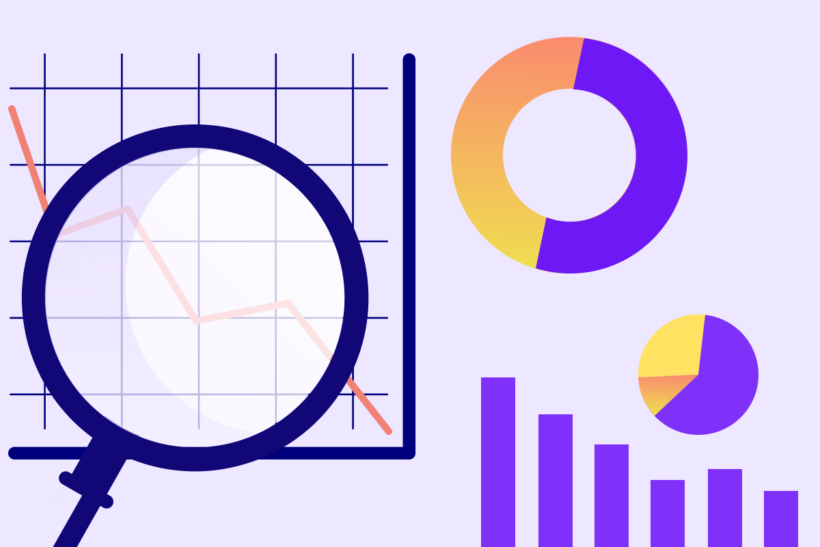
Income Statement Template for Visualizing Complex Financial Data
Learn more ->
SaaS businesses have different analytical needs than their non-SaaS counterparts; to address those differences and still get the financial insights you need to make business decisions, use a SaaS financial modeling template.


What many FP&A platforms fail to do is consider a variety of business models. Because of the SaaS model we operate with, we’re very familiar with the frustrations that come with finding the right tools to deliver critical insights. Instead of searching for a product that checked all the boxes, we created Abacum, and now, your search can end here.
Content created by: Sasha Lamachenka, DemandGen Manager at Abacum
Impress investors. Satisfy stakeholders. Meet revenue goals. Cut costs. Grow the business. Business leaders in all sectors across the globe are met with a wide range of financial demands from all different angles. Whether they’re fundraising, closing a partnership deal, or launching a new product, business owners and CEOs need advanced financial models that are easily accessible and actionable.
10 years ago, financial modeling looked a lot simpler than it does today. Businesses would work in a Microsoft Excel file, apply some arbitrary rules and calculations to their revenue numbers and expenditures, and then predict what the coming months would bring from a financial perspective. Today, as businesses and modeling technologies have gotten more advanced, the expectations around financial modeling are different.
Higher accuracy, real-time updates, seamless visualizations, and self-service modeling interfaces are now the status quo. To further complicate financial modeling requirements, Software-as-a-Service (SaaS) businesses operate differently than companies that sell products to consumers or consulting services, for instance.
Financial metrics for SaaS businesses are slightly different than financial metrics for other business structures, adding another layer of complexity to building accurate financial models. Don’t stress – we’ve got you covered. We’ll detail the basics of SaaS financial models, how to use SaaS financial modeling templates, and what you can do to help your SaaS business exceed all expectations.
A financial model sheds light on the financial outcome of a business’s operations within a certain time period. Different financial models can be used for various business metrics: cash flow, net income, capital expenditures, and so much more. Anything business transaction that has a monetary value attached to it can become part of a financial model.
For most businesses, financial modeling is done to plan for future expected revenue and expenses, monitor strategic investments, and conduct scenario testing when pulling different business levers. Businesses can then incorporate specific nuances or transactional trends that they see over time within their financial models, making them more accurate in the long term.
All businesses – from early-stage business plans to late-stage SaaS startup endeavors, and even massive enterprises – rely on financial projections and financial planning to make the right decisions for their business.
Following many of the same financial modeling principles as non-tech-focused businesses, a SaaS financial model template is used for SaaS businesses. These types of businesses provide Software-as-a-Service, often creating online platforms or integrated solutions to some of the biggest challenges in today’s technology landscape.
SaaS businesses you’ll recognize immediately are:
Because these types of businesses usually operate on a different revenue model – such as a subscription-based model or a “freemium” model – their financial planning has to take that into account. It’s not the same as selling a widget to a customer, rather, it requires long-term contractual agreements between SaaS businesses and their clients.
A SaaS financial model is targeted toward SaaS businesses; these models account for the additional complexities that come with monitoring revenue, allocating spend, and making investment decisions within a SaaS business.
Among business leaders, it’s common knowledge that Business-to-Business (B2B) financial structures and Business-to-Consumer (B2C) structures require a different approach. If your SaaS solution plays within the B2B realm, your SaaS financial model templates will be different from SaaS businesses that work directly with consumers in the B2C space.
When designing a SaaS financial modeling solution for your organization, be sure to consider the multitude of factors that will impact the metrics you should be monitoring and the goals your organization should focus on.
If you have a business model that offers B2C and B2B products or solutions, you should be tracking and analyzing those sectors of your business independently. Sure, they’ll come together to give a holistic business view at some point in the process, but without the right metrics and detailed analysis for each, you’ll be losing out on valuable insights that can help you transform your business performance.
Since SaaS metrics vary from traditional financial modeling metrics, let’s dive into what some of the key metrics are and how they relate to your SaaS business or startup.
ARR, which can be referred to as the Annual Recurring Revenue, represents the money a business has coming in on a yearly basis, offering a wider scope than MRR, its monthly counterpart. If your business signs multi-year subscription contracts, you may place a higher emphasis on ARR, but for many businesses, MRR paints a picture in the near term, giving you the space you need to change your customer approach or manage your contracts more effectively.
It’s important to note that a subscription revenue model is only one form of a SaaS revenue model, but because it is widely used and understood, we’ll refer to it often in this article.
The Annual Contract Value measures how valuable a single contract or customer is to your business within a given period. The higher your ACV is, the more incremental revenue you can depend on moving forward, giving you the freedom to invest back in your business. Use this metric to track the performance of your sales team and highlight upselling opportunities within your existing contracts.
Used in calculating the New ARR, the Average Revenue Per User helps businesses project future revenue outcomes. It is calculated by dividing the Total MRR by the number of users or subscribers in the month.
If you offer a “freemium” version of your solution, do not include those users when calculating the ARPU. Since they do not contribute to your revenue, adding these accounts into the mix would only dilute your revenue projections.
With a SaaS business, revenue accrues over time throughout the life of each subscription to your service. Churn is the loss of customers or revenue over time; when someone cancels or doesn’t renew their plan with your platform, your business is experiencing churn. MRR and ARR are both impacted by churn, so it’s important to keep your users happy if business success is your ultimate goal.
All the money spent on acquiring new customers is tracked via the Customer Acquisition Cost metric. When spending money on marketing campaigns or customer outreach, track all of the expenses and divide it based on the number of new customers within that same period. The result is your CAC.
Once the CAC metric is clear, take it one step further by calculating the CAC payback period; this will tell you how long it will take to make enough money to cover the cost of just one new customer. Essentially, this is your break-even point on a granular, customer-centric level.
The Lifetime Value (LTV) of a customer is found by multiplying your organization’s ARPU by the expected lifetime of that customer. Depending on the level of subscription that each customer signed up for, the LTV can vary widely.
The LTV:CAC Ratio highlights how much more valuable the lifetime value of a customer is compared to the costs associated with acquiring that customer. If the LTV of your customer isn’t high enough compared to the funds spent on drawing them in, then your pricing is off or your sales and marketing teams need to change their approach and reduce spend.
With a long list of different metrics and KPIs, it can be hard to know what the most important focal areas are. The above list is a great starting point but be sure to assess the uniqueness of your organization, consider the metrics that will lead to your overall success, and diligently track those metrics through every ebb and flow of doing business.
A business will falter without the right revenue model, but it will also falter if the cogs or operating expenses are not tracked and reigned in as necessary. Because of how robust the financial planning requirements are when it comes to growing a business, a SaaS financial modeling template is the tool businesses need to keep everything financially aligned, on track, and in the green moving forward.
When a SaaS financial modeling template is implemented correctly, your organization can rely on:
If SaaS benchmarks stayed too high level, business leaders would lose touch with the daily, actionable items that make a difference. With the right SaaS financial modeling template, you’ll get an all-access look into customer-level revenue expectations, spend patterns, and more. Not only does this equip your FP&A team with the information needed to positively influence the business, but it also gives improvement opportunities to your sales team.
How can they better engage a customer? Is there a time when customers generally leave? Why are they leaving? Can churn be prevented through outreach? These are all the critical points that would be impossible to reach without an advanced financial modeling template designed for your business.
Through the close tracking of ARR/New ARR and MRR/New MRR, along with related metrics, finance leaders have access to more advanced revenue forecast capabilities.
One great thing about SaaS businesses is that revenue can be meticulously tracked, and, at the first sign of underperformance, a mitigating action can be taken. A SaaS financial model template can be the difference between a hard month being a blip on the radar or an iceberg that sinks your ship.
Half the battle of business is getting the right people in the right places at the right time. By being able to see where additional sales representatives are needed within seconds, you can maintain a proactive business approach instead of a reactive one that is always 10 steps behind.
You can look to your SaaS financial model template when building a hiring plan or assessing employee retention metrics. Expanding your team is the best part of doing business; if you’re not sure how to scale, follow the advice of these 6 SaaS FP&A leaders.
Just like with the LTV:CAC ratio, if your revenue results don’t justify the money you’re spending on the way, then something needs to change!
Detailed analytics regarding operating expenses help entrepreneurs and business leaders make hard, cost-cutting decisions without guilt or bias; if you let the numbers speak for themselves, it can be amazing what they tell you.
Designed to answer all your business questions and chart a strategic plan moving forward, a SaaS financial model template can be used to create most of the financial statements you’ll need to run your business.
Although it’s not the best template if you need to look at balance sheet analytics, there is plenty it can do when comes to profit, loss, cash flow, and beyond.
Comprised of revenue, gross margin, and expenses, the profit and loss statement can be pulled entirely from a well-built, interactive SaaS financial model template. All of these components are easily found within a financial modeling template, making it easy for you to tap into the most important financial statements all from one centralized place.
The cash you have coming in needs to be sufficient to cover all the cash you have going out; if that’s not the case, then your business faces liquidity risks and may not be able to cover surprise expenses or payments. To tighten cash management within your organization, simply pull the transaction-level supporting detail from your SaaS financial model template, identify what’s causing the cash flow issues, and establish a plan to resolve those issues.
Whether you’re trying to conduct a business valuation, figure out the growth rate of your company, or dive deeper into customer conversion rates, all the information you need can be found within the SaaS financial model template. There’s no shortage of data in front of you, but this template makes it easy to make sense of the data and reach new levels of business success.
Since we first started serving customers, Abacum has operated as a SaaS business. Even in the early stage of doing business, we were navigating and perfecting our management of SaaS metrics, building the best financial modeling templates possible, and using them to improve our own performance.
Now, with our proprietary SaaS solution helping hundreds of small to mid-market businesses every year, we invested the same level of care into the SaaS financial modeling template available to our users as we did when we were trying to get it all right at our inception. The SaaS financial model template that we’ve created offers unique features and analytical capabilities that go above and beyond most similar templates that can be found today.
The functionality of our interface makes it quick and easy to see the data, understand what it’s telling you, and take the right next steps. As a SaaS company ourselves, we’ve built a template that will exceed your expectations. The best part? We’re committed to improving every template we offer as business landscapes change and data availability advances.
If you’re still using Microsoft Excel or Google Sheets to manage your SaaS metrics, you’re not alone! But respectfully, it might be time for a change. Excel has been a household name in the business world for decades and it’s not going anywhere, but there are incredible levels of productivity, efficiency, and accuracy to be found in pre-built, automated reporting tools.
Updating an Excel model usually requires a raw data pull, a hundred-thousand-row copy/paste into an existing template, and a quick “fingers crossed!” before clicking the “refresh” button. If you opt for a real-time reporting system like Abacum, all of those steps are done by the back-end systems. Not only does this approach give time back to your most valuable resources – your people, but it also boosts computing efficiency and has more sophisticated analytical capabilities than a clunky Excel worksheet.
Starting out, a B2B SaaS financial model calculates the revenue differently than more traditional models; while non-SaaS businesses can predict revenue based on sales, SaaS businesses need to look at different sources of recurring revenue, such as subscription revenue.
This foundational difference requires a different approach, and that’s exactly what we factored in when designing Abacum’s SaaS financial modeling offerings. We’ve incorporated the following features into our SaaS template because we know what it takes to run a SaaS business.
As you acquire new contracts or develop new revenue streams, your New ARR and New MRR will change. Instead of throwing together a model that requires manual updates and inputs with the slightest changes, Abacum is constantly calculating these KPIs as new data gets mixed into the fold. When you go onto our platform, you’ll always be looking at the most updated information, and as much as it seems like magic, it’s really just advanced computing capabilities.
We believe that the complexity of your business should be accounted for. If you are selling solutions in different regions around the world or want to monitor departments, functions, or business units at a detailed level, Abacum makes it easy.
Every business outcome tells a story, but sometimes, human input is needed to offer context. With our commentary columns, analysts and leaders alike can add context around business events and financial metrics as needed. If a big contract fell through or an unforeseen cyberattack ended up spiking expenses in a month, that information is needed when looking at the financial data.
If you’re ready to take your business to the next level, we truly believe that our SaaS financial modeling template is the key. As a SaaS B2B organization, we’re intimately familiar with critical SaaS metrics while still having an understanding that SaaS businesses require flexible, customizable solutions, and that is exactly what we created.
Reach out to our team for more information or a live look at what your SaaS financial template can look like in reality! Abacum can change your business, let us show you how.
A SaaS financial model requires all of the detailed financial data, sales data, and marketing data that your organization has access to. With the foundational data in place, you can either build your own financial model based on the metrics your organization needs to see or use a solution like Abacum to do all the heavy lifting.
SaaS financial models can be used to create revenue forecasts, cash flow forecasts, and churn analytics. Since all of the forecasting activities can be done in one, centralized place, it creates a streamlined process for the entire FP&A function and allows finance professionals to be more effective business partners.
